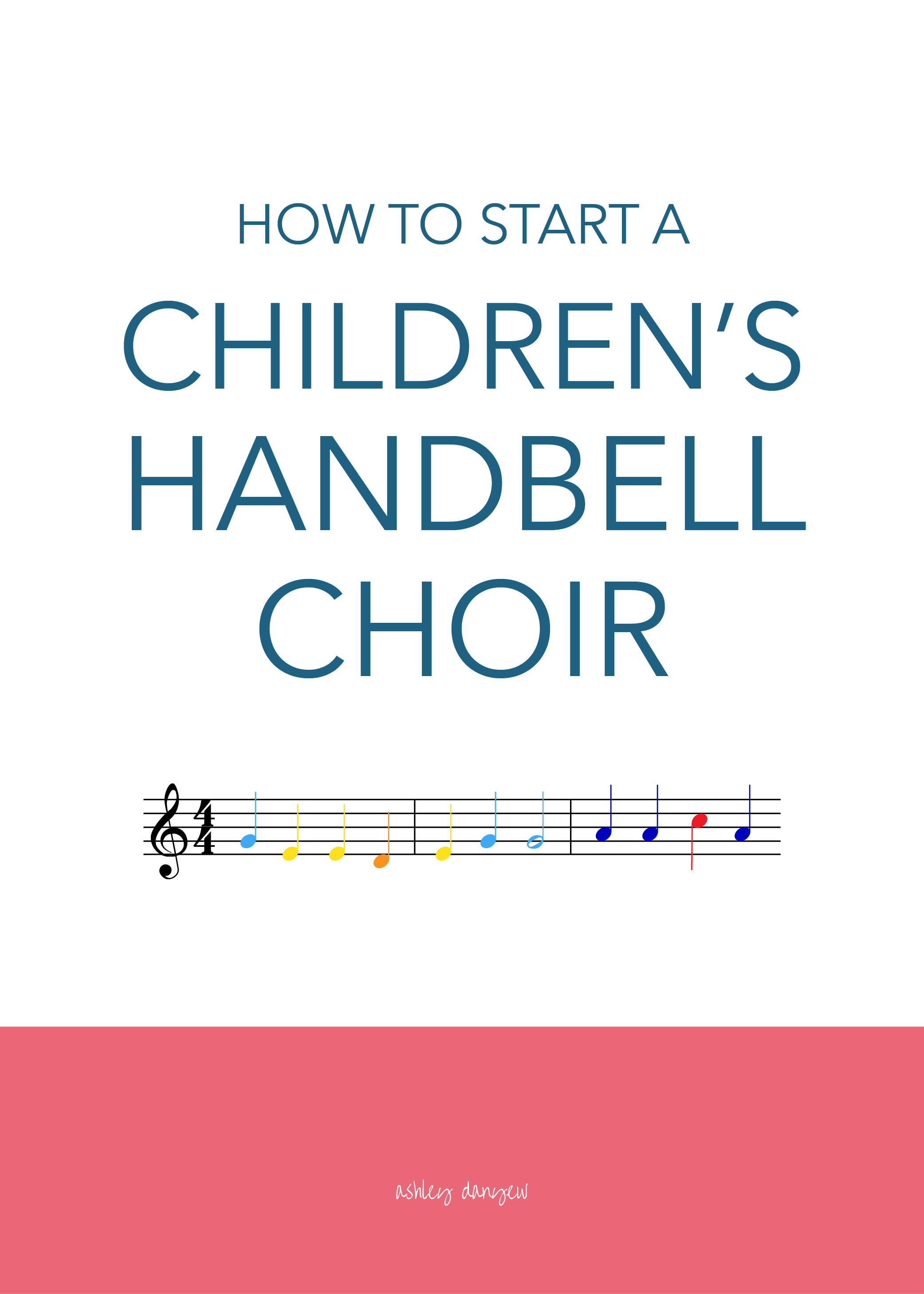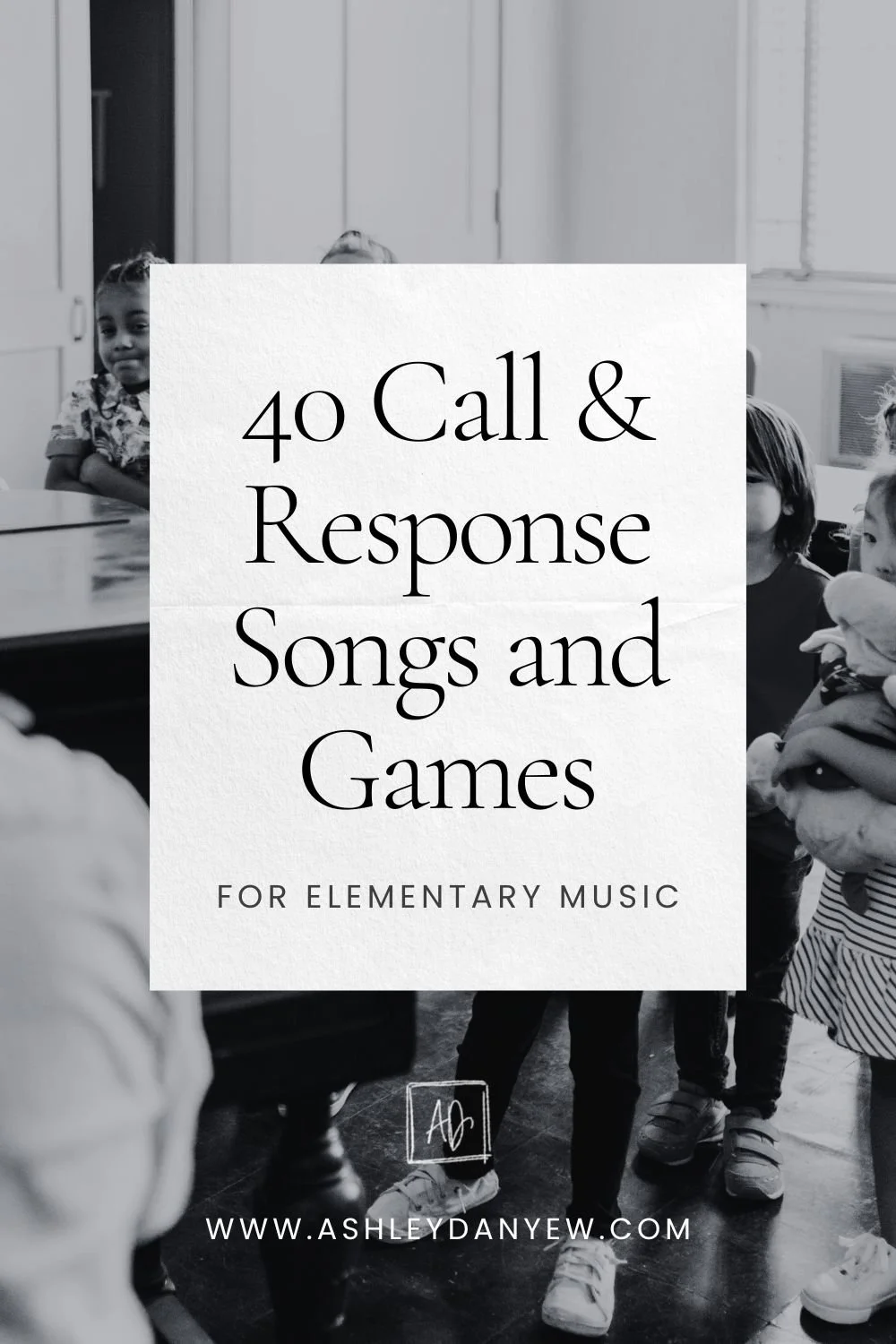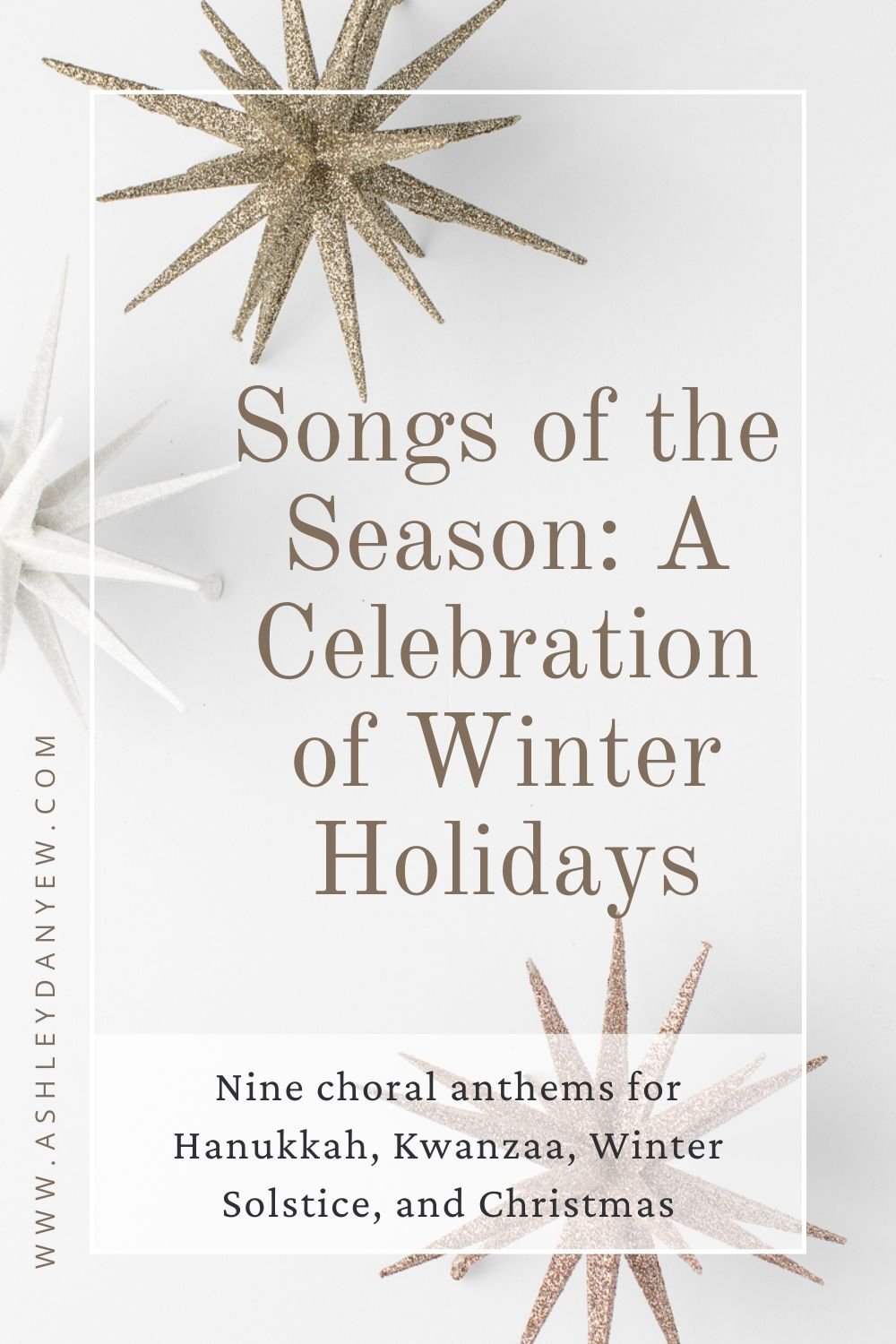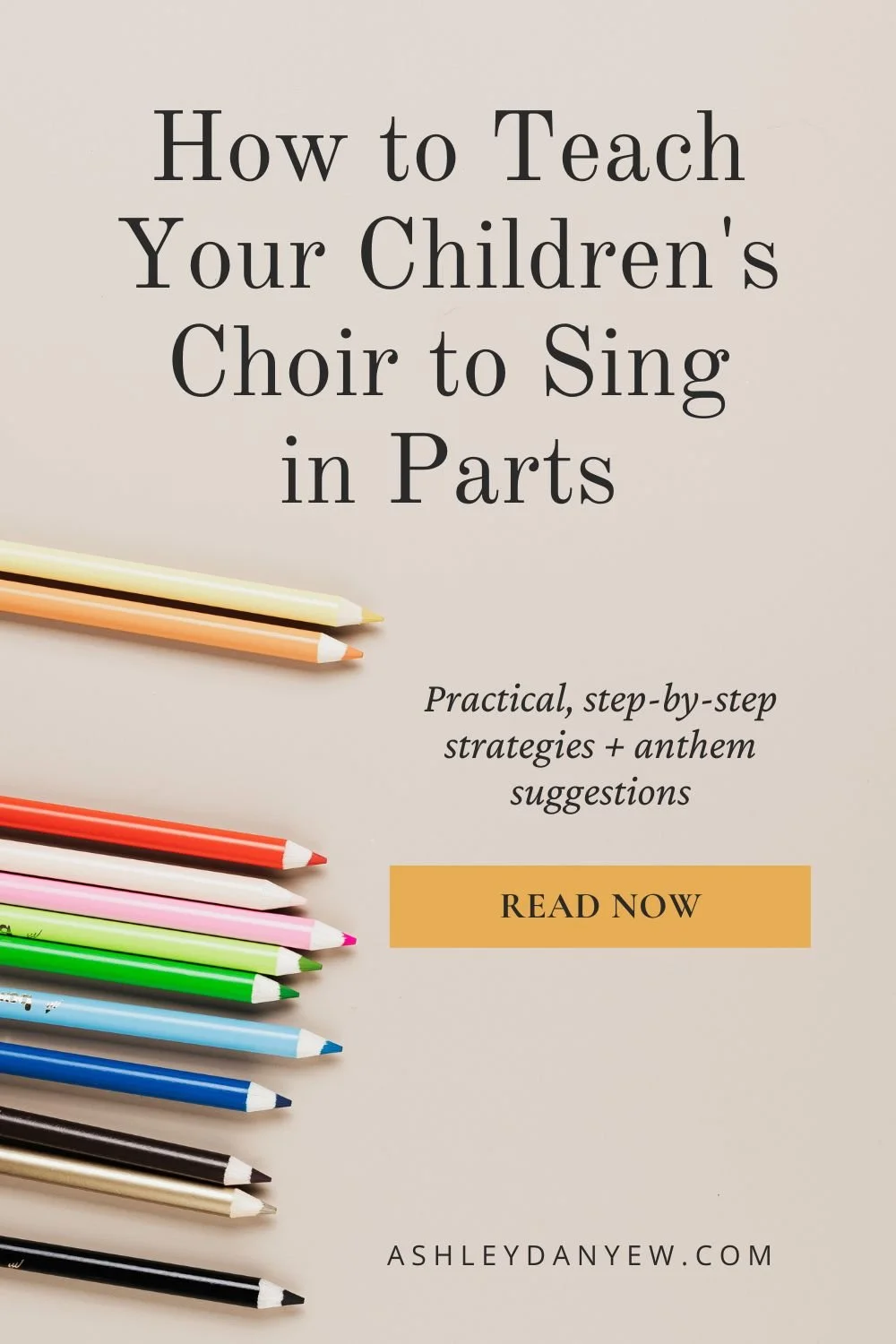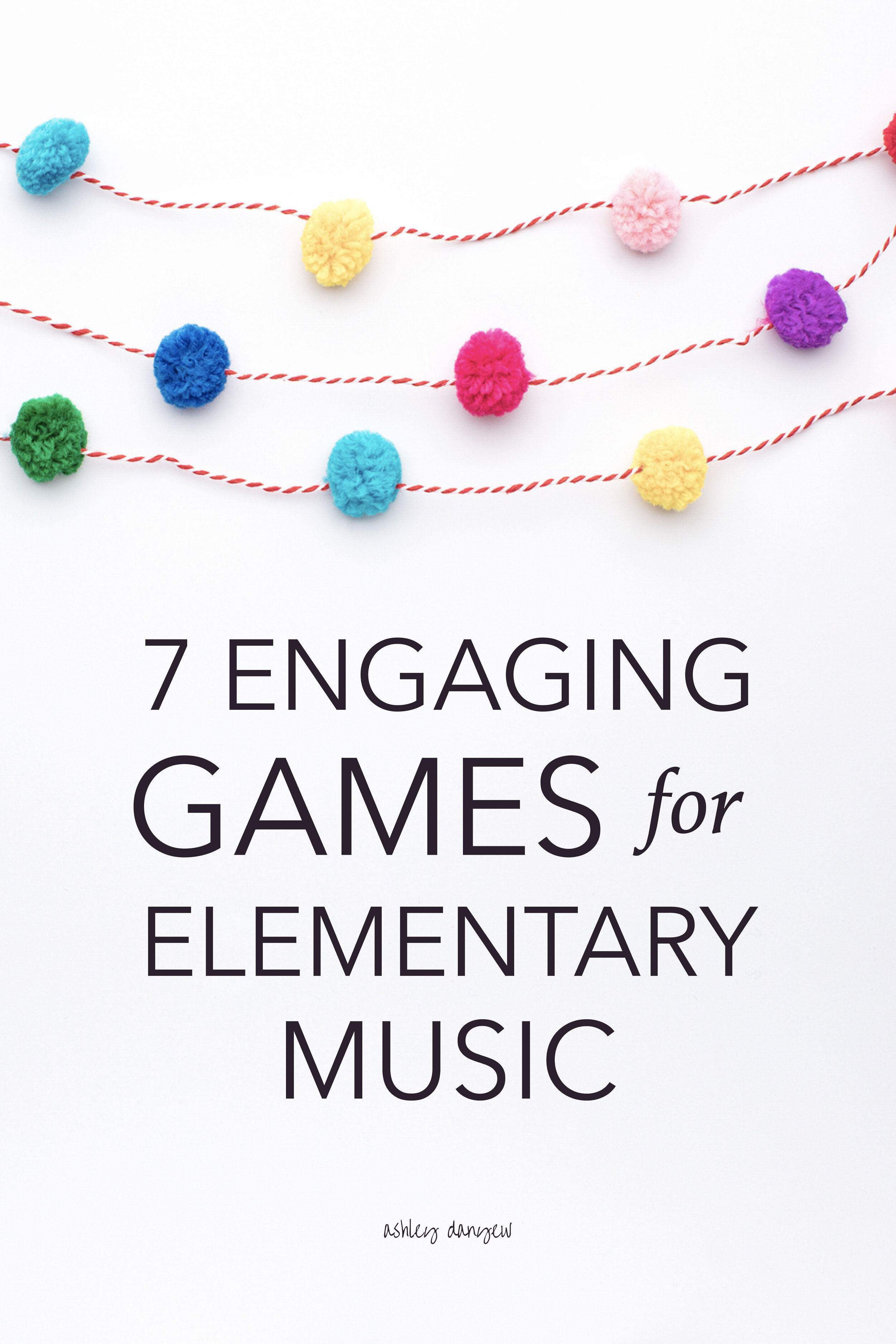Playing handbells is a great way to foster the development of strong rhythmic skills, physical coordination, and listening skills.
It's also an effective way to teach the basics of music-reading (direction, reading lines and spaces) and provide young children with an active way to play and make music together.
Yes, young children! With color-coded metal handbells, children as young as preschool-age can play handbells.
Each bell/note is a different color and music notation is often color-coded to match. Some music features colored note values (e.g. red for Middle C). Others use colored letter names or a picture of the colored bell with the letter name inside.
Looking to start a children's handbell choir at your church? Here are some of my favorite products, resources, and teaching aids. Happy ringing!
What You'll Need
*Disclosure: I get commissions for purchases made through links in this post.
Set of Rhythm Band colored handbells (the 8-note diatonic set or the 13-note chromatic set by Kids Play)
Colored markers (regular or dry-erase if you have a whiteboard)
Color-coded music or charts
Getting Started
Assign each child a bell (or two, if they're old enough and ready for the extra challenge). Explain how to hold and ring the bell, how to play a tremolo (gentle shake back and forth), and demonstrate resting the bell on your shoulder when not playing. Have children practice ringing and resting and explore the sound their bell makes.
One of the easiest ways to start playing is by writing out your own music. This doesn't necessarily mean composing, it just means notating simple patterns or translating existing music into colored notation that matches the colors of the bells. Use a whiteboard with staff lines, chart-size manuscript paper (like this), or a color-coded fabric staff.
A great visual teaching aid, this color-coded fabric staff includes 96 colored felt circles that match the colors of the Rhythm Band handbells. The junior size (18"x14") is small enough to hold or sit on a music stand; the larger size (28"x28") has a rope at the top for easy hanging. Here is a quick video demonstration of how to use the color-coded fabric staff.
Whether you're using a fabric staff or writing out the notes yourself, create three- or four-note tonal patterns for warm-up exercises, practice ringing a stepwise line going up or down, or write out simple chord changes (I, IV, V7) for a familiar carol, hymn, or song.
Give children an opportunity to compose by having them take turns creating their own patterns and short melodies.
Playing Chords
Chord Cards
Introduce chord-playing with this set of color-coded chord cards (try saying that five times in a row!). This 36-card set includes all twelve major and minor chords and twelve dominant chords with pictures of the colored bells needed to play each one. An invaluable tool for teaching basic chord knowledge and introducing chordal accompaniments to your bell choir!
Chords may be played once at the beginning of each measure (or every other measure, depending on the song) or played as a tremolo until the chord changes. This style of ringing works well with an instrumental accompaniment (pre-recorded or live) that features the melody.
Bells Alive
Rhythm Band has a series called Bells Alive that includes two general volumes (here and here) and a Christmas volume. Each volume includes a number of DVD lessons and practice and performance tracks for well-known pieces such as "Chopsticks," "Pachelbel's Canon," "Joy to the World," and "The First Noel."
The latter two volumes in the series include options for playing a single-note melody or layering the parts. A great, engaging way to introduce the notes of the scale, get children ringing in rhythm, introduce melody lines and basic chords, and teach bass lines. See the full table of contents here.
Teachers Pay Teachers
Teachers Pay Teachers is another good place to look. Here is a collection of Christmas carols featuring color-coded melody lines (with rhythmic notation) and chord charts for "Silent Night," "Joy to the World," "Coventry Carol," and "Away in a Manger."
For 1-octave colored handbells (8 bells).
A printable, reproducible collection of six familiar children’s songs and hymns.
Two versions of each song are included: one with colored letter names and one with colored noteheads on a music staff. Colors match the popular Rhythm Band handbells and Boomwhackers.
Written for just 8 bells, these pieces are easy to put together and accessible for smaller (and younger) groups of 4-8 ringers.
Playing Melodies
Children’s Handbell Collections
The Color-Ring Color-Coded Songbook has a mix of sacred and secular songs, including "Jingle Bells," "The First Noel," "Clementine," and "Joyful, Joyful." Eleven of the nineteen songs are playable with the diatonic 8-bell set; the remaining eight songs include some chromatic notes, playable with the 13-bell set.
Wayne Potash has a collection of music for color-coded bells, though you'll notice that he writes the melodies using color-coded letters instead of notes on a staff. In addition to pieces available for purchase, he also has a few free downloads, including "Do You Know the Muffin Man?" and "Oats, Peas, Beans, and Barley Grow."
The So Festive! blog has two color-coded handbell collections available: Christmas Songs and Classic Songs.
Miriam Risenhoover has a few collections of color-coded handbell music, many of which are available as digital downloads. Take a look at Christian Bell Song Book and Christmas Bell Song Book.
This site has many color-coded handbell song charts available (with lyrics); however, some have been modified to fit within a single octave.
Letter Cards
Notate any melody, hymn, or song with these color-coded letter cards from Camille's Primary Ideas. Simple print, cut, and assemble on a whiteboard, poster board, or oversized chart.
Note: Camille recommends cutting the cards into squares instead of trying to cut out the circles.
Many teachers and directors arrange cards like this in a grid—four cards across by five cards down, say. However, I think this approach leaves out one of the most essential components of music reading: direction.
Contrary to how we read words—in neat, linear rows, most of the time—music notation ascends and descends to match the direction of the musical line.
Instead of the grid approach, I suggest arranging note cards on an oversized music staff or at least showing the direction of the melody by positioning the cards in a way that shows the ascending or descending lines (commonly known as off-staff notation).
A Few Final Thoughts
Looking for more song ideas, music resources, and chord charts for children's bells? Here's a secret: Boomwhackers use the same color system as bells.
Boomwhackers are colored percussion tubes of various lengths tuned to musical pitches. Just like the handbell sets mentioned above, each tube/pitch is a different color. If you're having trouble finding new music for your bells to play, try searching for music and chord charts for Boomwhackers.
Related post: Your Go-To Guide for Using Boomwhackers with Your Children’s ChoirWhen playing pieces in worship or for a special event, some directors hold up cards as the chords change or point to a chart that everyone can see. Others point at children when it's their turn to play, though this often flattens the rhythm into notes of equal value and may hinder children from developing musical independence.
Whatever method you choose, try to create the best musical experience for the children that you can: be true to the melody and maintain rhythmic integrity. Give them opportunities to take ownership, experiment, and discover. Make it musical.
I’d love to hear from you.
Do you have a children's bell choir? What are your favorite teaching resources?
Related posts:
Fun, Easy Gathering Activities for Children's Choir
Adventures in Bell-Ringing: Improvisation Activities
How to Plan a Children's Choir Rehearsal


